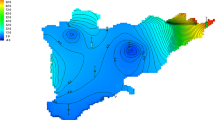Abstract
With the expansion of the scale of cities and the development of industries, the pressure on the land around the cities has also increased, and soil erosion has become more and more serious. Scientific and reasonable urban construction ensures the flow of river ecology foundation, which is very important for urban ecological construction and improving people’s quality of life. Based on artificial intelligence, this paper takes into account the practical problems of urban construction and development based on the basic flow of river ecosystems, and it is difficult to guarantee soil erosion. It discusses the characteristics and hazards of urban soil erosion and proposes the protection of soil and water in urban construction management. It can also optimize the content and layout of urban construction plans and provide experience for comprehensive management of soil erosion in urban construction. Especially after China has set a “service-oriented” government construction goal, the enhancement of performance evaluation has become the mainstream idea for local governments to implement structural reforms in providing sports public services. The performance evaluation of public sports services is an important foundation for the reform of government functions, strengthening the legitimacy of the government, protecting people’s sports and fitness rights, and promoting social justice and justice. This article constructs an index evaluation system for the spatial distribution of sports public service resources and plans to strengthen and balance public sports services according to different levels of requirements. At the same time, the rapid development and popularization of artificial intelligence have had a huge impact on the production and lifestyle of human society and brought challenges and opportunities to the development of public services.













Similar content being viewed by others
Change history
03 November 2021
This article has been retracted. Please see the Retraction Notice for more detail: https://doi.org/10.1007/s12517-021-08699-4
28 September 2021
An Editorial Expression of Concern to this paper has been published: https://doi.org/10.1007/s12517-021-08471-8
References
ASTM (1995) Standard test method for triaxial compressive strength of undrained rock core specimens without pore pressure measurements. ASTM Stand:D2664–D295a
Bohloli B, De Pater CJ (2006) Experimental study on hydraulic fracturing of soft rocks: influence of fluid rheology and confining stress. J Pet Sci Eng 53(1-2):1–12
Chang TK, Talei A, Quek C, Pauwels VRN (2018) Rainfall-runoff modelling using a self-reliant fuzzy inference network with flexible structure. J Hydrol 564:1179–1193 https://doi-org.proxy2.cl.msu.edu/10.1016/j.jhydrol.2018.07.074
Chanu SN, Kumar P (2016) Application of multilayer perceptron based artificial neural network for modeling of rainfall runoff in a Himalayan. 8th Int Conf Recent Innov Sci Eng Manag New Delhi, India, 21st Oct 15
Deutsch CV, Journel AG (1998) GSLIB: geostatistical software library and user’s guide. In: Oxford Univ. Press, New York. GSLIB: geostatistical software library and user’s guide, 2nd edn. Oxford Univ. Press, New York 384
Du Y, Zhang JL, Zheng SF, Xin J, Chen J, Li YZ (2015) The rudist buildup depositional model, reservoir architecture and development strategy of the cretaceous Sarvak Formation of Southwest Iran. Petroleum 1(1):16–26
Egbueri JC (2019) Evaluation and characterization of the groundwater quality and hydrogeochemistry of Ogbaru farming district in southeastern Nigeria. SN Appl Sci 1(8):851
Ezati M, Azizzadeh M, Riahi MA, Fattahpour V, Honarmand J (2020) Wellbore stability analysis using integrated geomechanical modeling: a case study from the Sarvak reservoir in one of the SW Iranian oil fields. Arab J Geosci 13(4):149
Hansen KM (1992) The use of sequential indicator simulation to characterize geostatistical uncertainty. In: No. SAND--91-0758. Labs, Sandia National
Hedayatikhah S, Abdideh M (2019) 3D Geomechanical modeling of casing collapse in plastic formations (Cap Rock of Hydrocarbon Reservoir). Nat Resour Res 28(1):273–286
Maleki S, Gholami R, Rasouli V, Moradzadeh A, Riabi RG, Sadaghzadeh F (2014) Comparison of different failure criteria in prediction of safe mud weigh window in drilling practice. Earth Sci Rev 136:36–58
Mariethoz, G., Renard, P., Cornaton, F. and Jaquet, O., (2011). High-resolution truncated plurigaussian simulations for the characterization of heterogeneous formations. arXiv preprint arXiv:1108.5485.
Nasehi MJ, Mortazavi A (2013) Effects of in-situ stress regime and intact rock strength parameters on the hydraulic fracturing. J Pet Sci Eng 108:211–221
Prudnikova A, Anashkin AEE (2008) Candidate selection process for fracturing combined with RPM treatments for Western Siberia oilfields based on case studies. SPE Russian Oil and Gas Technical Conference and Exhibition. Society of Petroleum Engineers, In
Queipo NV, Goicochea JV, Pintos S (2002) Surrogate modeling-based optimization of SAGD processes. J Pet Sci Eng 35(1-2):83–93
Rezvandehy M, Leung JY, Ren W, Hollands B, Pan G (2018) An improved workflow for permeability estimation from image logs with uncertainty quantification. Natural Resources Research, In, pp 1–35
Sfidari E, Kadkhodaie-Ilkhchi A, Rahimpour-Bbonab H, Soltani B (2014) A hybrid approach for litho-facies characterization in the framework of sequence stratigraphy: a case study from the South Pars gas field, the Persian Gulf basin. J Pet Sci Eng 121:87–102
Shadizadeh SR, Habibnia BA, Syllabee R (2009) Investigation and selection of suitable layers in bangestan reservoir for hydraulic fracturing operation. Scientia Iranica. Transaction C, Chemistry, Chemical Engineering 16(2):149–160
Taleghani AD, Gonzalez-Chavez M, Yu H, Asala H (2018) Numerical simulation of hydraulic fracture propagation in naturally fractured formations using the cohesive zone model. J Pet Sci Eng 165:42–57
Wang WC, Xu DM, Chau KW, Chen S (2013) Improved annual rainfall-runoff forecasting using PSO-SVM model based on EEMD. J Hydroinf 15:1377–1390 https://doi-org.proxy2.cl.msu.edu/10.2166/hydro.2013.134
Zhang SC, Lei X, Zhou YS, Xu GQ (2015) Numerical simulation of hydraulic fracture propagation in tight oil reservoirs by volumetric fracturing. Pet Sci 12(4):674–682
Author information
Authors and Affiliations
Corresponding author
Ethics declarations
Conflict of interest
The author(s) declare that they have no competing interests.
Additional information
Responsible Editor: Sheldon Williamson
This article is part of the Topical Collection on Environment and Low Carbon Transportation
This article has been retracted. Please see the retraction notice for more detail: https://doi.org/10.1007/s12517-021-08699-4
About this article
Cite this article
He, F. RETRACTED ARTICLE: Artificial intelligence-based water and soil erosion around cities and spatial distribution of sports public service resources. Arab J Geosci 14, 1252 (2021). https://doi.org/10.1007/s12517-021-07363-1
Received:
Accepted:
Published:
DOI: https://doi.org/10.1007/s12517-021-07363-1




